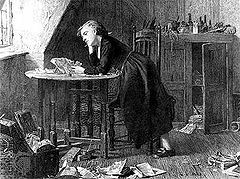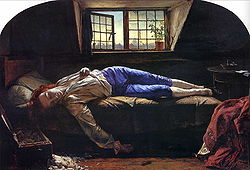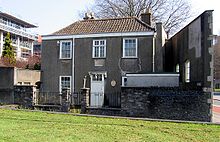- Thomas Chatterton
-
"Chatterton" redirects here. For other uses, see Chatterton (disambiguation).
Thomas Chatterton 
Born 20 November 1752
Bristol, EnglandDied 24 August 1770 (aged 17)
Holborn, EnglandPen name Thomas Rowley Occupation Poet, forger Thomas Chatterton (20 November 1752 – 24 August 1770) was an English poet and forger of pseudo-medieval poetry. He died of arsenic poisoning, either from a suicide attempt or self-medication for a venereal disease.[1]
Contents
Childhood
Thomas Chatterton was born in Bristol where the office of sexton of St. Mary Redcliffe had long been held by the Chatterton family. The poet's father, also named Thomas Chatterton, was a musician, a poet, a numismatist, and a dabbler in the occult. He had been a sub-chanter at Bristol Cathedral and master of the Pyle Street free school, near Redcliffe church.
After Thomas's birth (four months after his father's death), his mother established a girls' school and took in sewing and ornamental needlework. Thomas was admitted to Edward Colston's Charity, a Bristol charity school, in which the curriculum was limited to reading, writing, arithmetic and the catechism.
Thomas, however, was always fascinated with his uncle the sexton and the church of St Mary Redcliffe. The knights, ecclesiastics and civic dignitaries on its altar tombs, became familiar to him. Then he found a fresh interest in oaken chests in the muniment room over the porch on the north side of the nave, where parchment deeds, old as the Wars of the Roses, lay forgotten. Thomas learned his first letters from the illuminated capitals of an old musical folio, and learned to read out of a black-letter Bible. He did not like, his sister said, reading out of small books. Wayward from his earliest years, and uninterested in the games of other children, he was thought to be educationally backward. His sister relates that on being asked what device he would like painted on a bowl that was to be his, he replied, "Paint me an angel, with wings, and a trumpet, to trumpet my name over the world."
From his earliest years he was liable to fits of abstraction, sitting for hours in what seemed like a trance, or crying for no reason. His lonely circumstances helped foster his natural reserve, and to create the love of mystery which exercised such an influence on the development of his genius. When Chatterton was six, his mother began to recognize his capacity; at eight he was so eager for books that he would read and write all day long if undisturbed; by the age of eleven, he had become a contributor to Felix Farley's Bristol Journal.
His confirmation inspired him to write some religious poems published in this paper. In 1763 a beautiful cross which had adorned the churchyard of St Mary Redcliffe for upwards of three centuries was destroyed by a churchwarden. The spirit of veneration was strong in Chatterton, and he sent to the local journal on 7 January 1764 a clever satire on the parish vandal. He also liked to lock himself in a little attic which he had appropriated as his study; and there, with books, cherished parchments, saved from the loot of the muniment room of St Mary Redcliffe, and drawing materials, the child lived in thought with his 15th century heroes and heroines.
First "medieval" works
The first of his literary mysteries, the dialogue of "Elinoure and Juga", was written before he was 12, and he showed it to Thomas Phillips, the usher at the boarding school Colston's Hospital where he was a pupil, pretending it was the work of a 15th-century poet. Chatterton remained a boarder at Colston's Hospital for more than six years, and it was only his uncle who encouraged the pupils to write. Three of Chatterton's companions are named as youths whom Phillips's taste for poetry stimulated to rivalry; but Chatterton told no one about his own more daring literary adventures. His little pocket-money was spent on borrowing books from a circulating library; and he ingratiated himself with book collectors, in order to obtain access to John Weever, William Dugdale and Collins, as well as to Thomas Speght's edition of Chaucer, Spenser and other books.
Chatterton's "Rowleian" jargon appears to have been chiefly the result of the study of John Kersey's Dictionarium Anglo-Britannicum, and it seems his knowledge even of Chaucer was very slight. His holidays were mostly spent at his mother's house, and much of them in the favourite retreat of his attic study there. He lived for the most part in an ideal world of his own, in the reign of Edward IV, when the great Bristol merchant William II Canynges(d.1474), five times mayor of Bristol, patron and rebuilder of St Mary Redcliffe "still ruled in Bristol's civic chair". Canynges was familiar to him from his recumbent effigy in Redcliffe church, and is represented by Chatterton as an enlightened patron of art and literature.
Adopts persona of Thomas Rowley
He soon conceived the romance of Thomas Rowley, an imaginary monk of the 15th century, and adopted for himself the pseudonym Thomas Rowley for poetry and history. Rowley's dramatic interludes were written for studies. In 1769 Chatterton sent Rowley's History of England, allegedly by Rowley, to Horace Walpole, who was briefly taken in.
Political writings
Chatterton now turned his attention to periodical literature and politics, and exchanged Felix Farley's Bristol Journal for the Town and Country Magazine and other London periodicals. Assuming the vein of Junius - then in the full blaze of his triumph — he turned his pen against the Duke of Grafton, the Earl of Bute, and Augusta of Saxe-Gotha, the Princess of Wales.
Determines on leaving Bristol
He had just dispatched one of his political diatribes to the Middlesex Journal, when he sat down on Easter Eve, 17 April 1770, and penned his "Last Will and Testament," a strange satirical compound of jest and earnest, in which he intimated his intention of ending his life the following evening. Among his satirical bequests, such as his "humility" to the Rev. Mr Camplin, his "religion" to Dean Barton, and his "modesty" along with his "prosody and grammar" to Mr Burgum, he leaves "to Bristol all his spirit and disinterestedness, parcels of goods unknown on its quay since the days of Canynge and Rowley." In more genuine earnestness he recalls the name of Michael Clayfield, a friend to whom he owed intelligent sympathy. The will was probably purposely prepared in order to frighten his master into letting him go. It had the desired effect. Lambert cancelled his indentures, his friends and acquaintances donated money, and he went to London.
London
Chatterton was already known to the readers of the Middlesex Journal as a rival of Junius, under the nom de plume of Decimus. He had also been a contributor to Hamilton's Town and Country Magazine, and speedily found access to the Freeholder's Magazine, another political miscellany supportive of John Wilkes and liberty. His contributions were accepted, but the editors paid little or nothing for them.
He wrote hopefully to his mother and sister, and spent his first earnings in buying gifts for them. His pride and ambition were gratified by the promises and interested flattery of editors and political adventurers; Wilkes himself had noted his trenchant style "and expressed a desire to know the author"; and Lord Mayor William Beckford graciously acknowledged a political address of his, and greeted him "as politely as a citizen could." He was abstemious and diligence was great. He could assume the style of Junius or Tobias Smollett, reproduce the satiric bitterness of Charles Churchill, parody Macpherson's Ossian, or write in the manner of Pope, or with the polished grace of Thomas Gray and William Collins.
He wrote political letters, eclogues, lyrics, operas and satires, both in prose and verse. In June 1770 - after nine weeks in London - he moved from Shoreditch, where he had lodged with a relative, to an attic in Brook Street, Holborn. He was still short of money; and now state prosecutions of the press rendered letters in the Junius vein no longer admissible, and threw him back on the lighter resources of his pen. In Shoreditch, he had shared a room; but now, for the first time, he enjoyed uninterrupted solitude. His bed-fellow at Mr Walmsley's, Shoreditch, noted that much of the night was spent by him in writing; and now he could write all night. The romance of his earlier years revived, and he transcribed from an imaginary parchment of the old priest Rowley his "Excelente Balade of Charitie." This fine poem, perversely disguised in archaic language, he sent to the editor of the Town and Country Magazine, and had it rejected.
Mr Cross, a neighbouring apothecary, repeatedly invited him to join him at dinner or supper; but he refused. His landlady also, suspecting his necessity, pressed him to share her dinner, but in vain. "She knew," as she afterwards said, "that he had not eaten anything for two or three days." But he assured her that he was not hungry. The note of his actual receipts, found in his pocket-book after his death, shows that Hamilton, Fell and other editors who had been so liberal in flattery, had paid him at the rate of a shilling for an article, and less than eightpence each for his songs; much which had been accepted was held in reserve and still unpaid for.
According to his foster-mother, he had wished to study medicine with Barrett, and in his desperation he wrote to Barrett for a letter to help him to an opening as a surgeon's assistant on board an African trader. On 24 August 1770, he retired for the last time to his attic in Brook Street, carrying with him the arsenic which he drank, after tearing into fragments whatever literary remains were at hand. He was only 17 years and nine months old; but the best of his numerous productions, in prose and verse, seem very mature.
He pictures John Lydgate, the monk of Bury St Edmunds, challenging Rowley to a trial at versemaking, and under cover of this fiction, produces his Songe of Alla, a piece of rare lyrical beauty. Again, in his Tragedy of Goddwyn, of which only a fragment has been preserved, the Ode to Liberty, with which it abruptly closes, may claim a place among the finest martial lyrics in the English language. The collection of poems in which such specimens occur furnishes by far the most remarkable example of intellectual precocity in the whole history of English literature.
Posthumous recognition
 The Death of Chatterton, 1856, by Henry Wallis, the most famous image of Chatterton in the 19th century. The figure of the poet was modelled by the young George Meredith
The Death of Chatterton, 1856, by Henry Wallis, the most famous image of Chatterton in the 19th century. The figure of the poet was modelled by the young George Meredith
The death of Chatterton attracted little notice at the time; for the few who then entertained any appreciative estimate of the Rowley poems regarded him as their mere transcriber. He was interred in a burying-ground attached to the Shoe Lane Workhouse, in the parish of St Andrew, Holborn, later converted into a site for Farringdon Market. There is a discredited story that the body of the poet was recovered, and secretly buried by his uncle, Richard Phillips, in Redcliffe Churchyard. There a monument has since been erected to his memory, with the appropriate inscription, borrowed from his "Will," and so supplied by the poet's own pen. "To the memory of Thomas Chatterton. Reader! judge not. If thou art a Christian, believe that he shall be judged by a Superior Power. To that Power only is he now answerable."
It was after Chatterton's death that the controversy over his work began. Poems supposed to have been written at Bristol by Thomas Rowley and others, in the Fifteenth Century (1777) was edited by Thomas Tyrwhitt, a Chaucerian scholar who believed them genuine medieval works. However, the appendix to the following year's edition recognises that they were probably Chatterton's own work. Thomas Warton, in his History of English Poetry (1778) included Rowley among 15th century poets, but apparently did not believe in the antiquity of the poems. In 1782 a new edition of Rowley's poems appeared, with a "Commentary, in which the antiquity of them is considered and defended," by Jeremiah Milles, dean of Exeter.
The controversy which raged round the Rowley poems is discussed in Andrew Kippis, Biographia Britannica (vol. iv., 1789), where there is a detailed account by G Gregory of Chatterton's life (pp. 573–619). This was reprinted in the edition (1803) of Chatterton's Works by Robert Southey and J Cottle, published for the benefit of the poet's sister. The neglected condition of the study of earlier English in the 18th century alone accounts for the temporary success of Chatterton's mystification. It has long been agreed that Chatterton was solely responsible for the Rowley Poems, but the language and style were analysed in confirmation of this view by W. W. Skeat in an introductory essay prefaced to vol. ii. of The Poetical Works of Thomas Chatterton (1871) in the "Aldine Edition of the British Poets." The Chatterton manuscripts, originally in the possession of William Barrett of Bristol, were left by his heir to the British Museum in 1800. Others are preserved in the Bristol library.
Chatterton's genius and his death are commemorated by Shelley in Adonais (though its main emphasis is the commemoration of Keats), by Wordsworth in "Resolution and Independence", by Coleridge in "A Monody on the Death of Chatterton," by Dante Gabriel Rossetti in "Five English Poets," by Henry Wallis in his painting "The Death of Chatterton," and in John Keats' sonnet "To Chatterton". Keats also inscribed Endymion "to the memory of Thomas Chatterton". Alfred de Vigny's drama of Chatterton gives an altogether fictitious account of the poet. Herbert Croft, in his Love and Madness, interpolated a long and valuable account of Chatterton, giving many of the poet's letters, and much information obtained from his family and friends (pp. 125–244, letter Ii.).
Two of Chatterton's poems were set to music as glees by the English composer John Wall Callcott. These include separate settings of distinct verses within the Song to Aelle. His best known poem, O synge untoe mie roundelaie was set to a five part madrigal by Samuel Wesley. Chatterton has attracted operatic treatment a number of times throughout history, notably Ruggiero Leoncavallo's largely unsuccessful 2 Act "Chatterton"; The German composer Matthias Pinscher's modernistic "Thomas Chatterton"; and Australian composer Matthew Dewey's lyrical yet dramatically intricate one-man mythography entitled "The Death of Thomas Chatterton".
There is a collection of "Chattertoniana" in the British Museum, consisting of works by Chatterton, newspaper cuttings, articles dealing with the Rowley controversy and other subjects, with manuscript notes by Joseph Haslewood, and several autograph letters. E. H. W. Meyerstein, who worked for many years in the manuscript room of the British Museum wrote a definitive work - "A life of Thomas Chatterton" - in 1930. Peter Ackroyd's 1987 novel Chatterton was an acclaimed literary re-telling of the poet's story, giving emphasis to the philosophical and spiritual implications of forgery.
In 1928 a plaque in memory of Chatterton was mounted on 39, Brooke Street, Holborn, bearing the inscription below.[2] The plaque has subsequently been transferred to a modern office building on the same site.[3]
In a House on this Site Thomas Chatterton, died August 24, 1770.
Within Bromley Common, is a road called Chatterton Road, this is the main throughware in Chatterton Village, based around the public house The Chatterton Arms. Both road and pub are named after the poet.[4]
French singer Serge Gainsbourg entitled one of his songs Chatterton, stating:
- Chatterton suicidé
- Hannibal suicidé [...]
- Quant à moi
- Ça ne va plus très bien.
The song was covered (in Portuguese) by Seu Jorge live and recorded in the album Ana & Jorge: Ao Vivo.
References
 This article incorporates text from a publication now in the public domain: Chisholm, Hugh, ed (1911). Encyclopædia Britannica (11th ed.). Cambridge University Press.
This article incorporates text from a publication now in the public domain: Chisholm, Hugh, ed (1911). Encyclopædia Britannica (11th ed.). Cambridge University Press.- ^ "Thomas Chatterton". Poets' Graves. http://www.poetsgraves.co.uk/chatterton.htm. Retrieved 16 November 2009.
- ^ Wright, GW. The London memorial to Thomas Chatterton, Notes and Queries, December 15th 1928, Oxford University Press. http://nq.oxfordjournals.org/content/CLV/dec15/419.full.pdf+html?sid=70499cda-fc67-48b1-afa9-496dc8255c0b
- ^ Google Streetview, 39 Brooke St, Camden Town, Greater London EC1N
- ^ http://www.guide2bromley.com/news/232/Chatterton-Village-Bromley-Common
External links
- Works by Thomas Chatterton at Project Gutenberg
- The Rowley Poems at Exclassics.com
- "Chatterton - A Novel" by Peter Ackroyd, Hamish Hamilton, London 1987
Categories:- English poets
- Literary hoaxes
- Forgers
- Poets who committed suicide
- Writers who committed suicide
- People from Bristol
- Suicides by poison
- 1752 births
- 1770 deaths
- British child writers
- Suicides in London
- People educated at Colston's School
Wikimedia Foundation. 2010.

